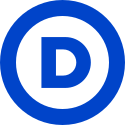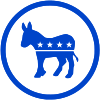
Democratic Party (United States)
American political party / From Wikipedia, the free encyclopedia
Dear Wikiwand AI, let's keep it short by simply answering these key questions:
Can you list the top facts and stats about Democratic Party (United States)?
Summarize this article for a 10 years old
The Democratic Party is one of two major contemporary political parties in the United States. Founded in 1828, it was predominantly built by Martin Van Buren, who assembled politicians in every state behind war hero Andrew Jackson, making it arguably the world's oldest active political party.[13][14][15] The party is a big tent of competing and often opposing viewpoints,[16][17] but modern American liberalism, a variant of social liberalism, is the party's majority ideology.[6][18] The party also has notable centrist[19] and social democratic[11] factions. Its main political rival has been the Republican Party since the 1850s.
Democratic Party | |
|---|---|
 | |
| Chairperson | Jaime Harrison |
| Governing body | Democratic National Committee[1][2] |
| Founders | |
| Founded | January 8, 1828; 195 years ago (1828-01-08)[3] Baltimore, Maryland, U.S. |
| Preceded by | Democratic-Republican Party |
| Headquarters | 430 South Capitol St. SE, Washington, D.C., U.S. |
| Student wing | |
| Youth wing | Young Democrats of America |
| Women's wing | National Federation of Democratic Women |
| LGBT wing | Stonewall Democrats[4] |
| Overseas wing | Democrats Abroad |
| Membership (2022) | |
| Ideology | |
| International affiliation | Alliance of Democrats[12] (2005–2012) |
| Colors | Blue |
| Seats in the Senate | 48 / 100[lower-alpha 1] |
| Seats in the House of Representatives | 212 / 435 |
| State governorships | 24 / 50[lower-alpha 2] |
| Seats in state upper chambers | 857 / 1,973 |
| Seats in state lower chambers | 2,425 / 5,413 |
| Territorial governorships | 4 / 5 |
| Seats in territorial upper chambers | 31 / 97 |
| Seats in territorial lower chambers | 9 / 91 |
| Election symbol | |
 | |
| Website | |
| democrats | |
The historical predecessor of the Democratic Party is considered to be the left-wing Democratic-Republican Party.[20][21] Before 1860, the Democratic Party supported expansive presidential power,[22] the interests of slave states,[23] agrarianism,[24] and expansionism,[24] while opposing a national bank and high tariffs.[24] It split in 1860 over slavery and won the presidency only twice[lower-alpha 3] between 1860 and 1910, although it won the popular vote a total of four times in that period. In the late 19th century, it continued to oppose high tariffs and had fierce internal debates on the gold standard. In the early 20th century, it supported progressive reforms and opposed imperialism, with Woodrow Wilson winning the White House in 1912 and 1916.
Since Franklin D. Roosevelt and his New Deal coalition after 1932, the Democratic Party has promoted a social liberal platform, including Social Security and unemployment insurance.[6][25][26] The New Deal attracted strong support for the party from recent European immigrants but diminished the party's pro-business wing.[27][28][29] Following the Great Society era of progressive legislation under Lyndon B. Johnson, the core bases of the parties shifted, with the Southern states becoming more reliably Republican and the Northeastern states becoming more reliably Democratic.[30][31] The party's labor union element has become smaller since the 1970s,[32][33] and as the American electorate shifted in a more conservative direction following Ronald Reagan's presidency, the election of Bill Clinton marked a move for the party toward the Third Way, moving the party's economic stance towards market-based economic policy.[34][35][36] Barack Obama oversaw the party's passage of the Affordable Care Act in 2010.
The party's philosophy of modern American liberalism blends civil liberty and social equality with support for a mixed capitalist economy.[37] On social issues, it advocates for abortion rights,[38] the legalization of marijuana,[39] stricter gun laws,[40] LGBT rights,[41] as well as criminal justice[42] and immigration reform.[43] Expansion of social programs, including enacting universal healthcare coverage,[44] equal opportunity, and consumer protection form the core of its economic agenda.[45][46][47] On abortion, trade, immigration, and foreign policy, the party has taken widely varying positions throughout its history.[48][49][50]
As of the 2020s, the party does best among Jewish and Black Americans, women, postgraduates, higher-income voters, sexual minorities, and individuals who live in urban areas. Democrats hold the presidency and a majority in the U.S. Senate, as well as 24 state governorships, 19 state legislatures, 17 state government trifectas, and the mayorships in the majority of the country's major cities.[51] By registered members, the Democratic Party is the largest party in the United States and the third largest in the world. Including the incumbent, Joe Biden, 16 Democrats have served as president of the United States.[6]